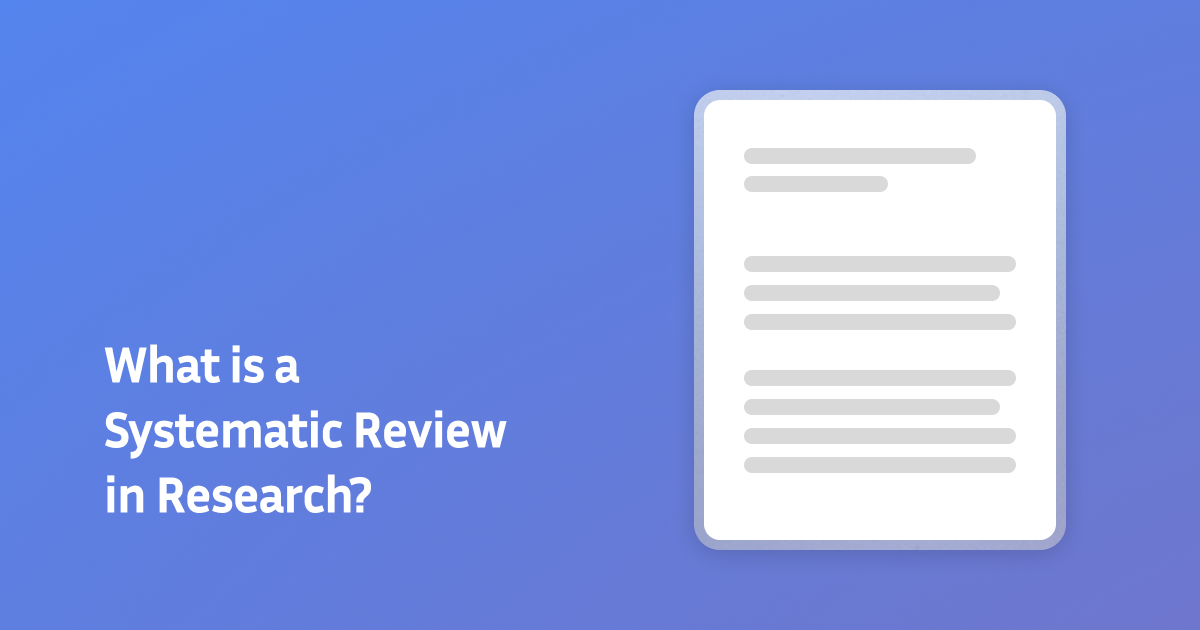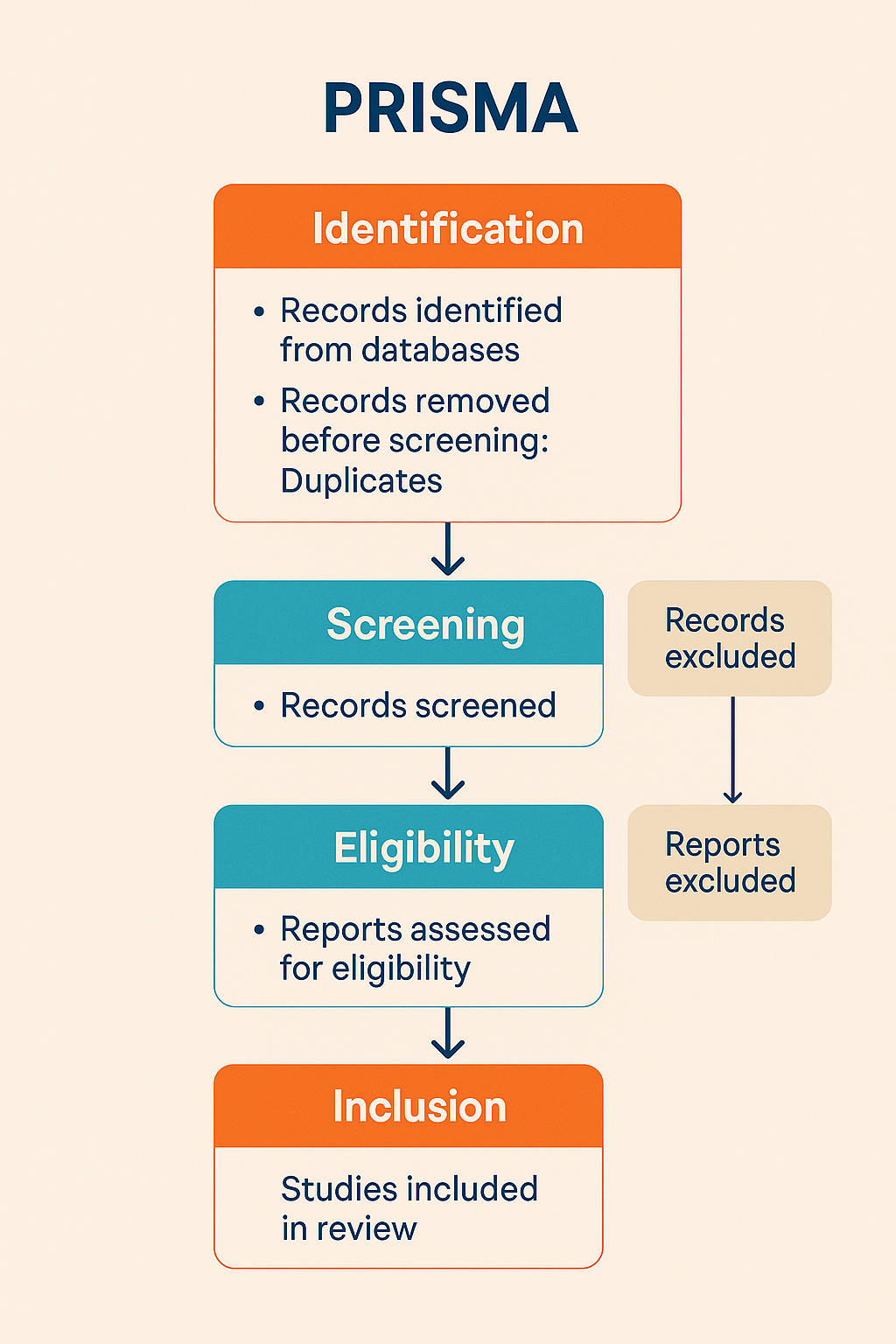What is a Systematic Review in Research?

A systematic review is a structured approach to gathering, evaluating, and synthesizing all available research evidence on a specific research question. In this guide, we walk through the systematic review process, its importance, and the best practices you need to follow to conduct a thorough and comprehensive review in 2025.
Quick Comparison of Systematic Review Approaches
| Approach | Description | Key Features | Best For | Duration |
|---|---|---|---|---|
| Systematic Review | Comprehensive, methodical synthesis of all research | Clear research question, predefined criteria | Research with substantial existing literature | Several months |
| Narrative Review | Broad synthesis, often expert-driven | Flexible structure, expert opinions | Overview of a research field | Weeks to months |
| Meta-Analysis | Quantitative synthesis of data | Statistical analysis of research findings | Topics with sufficient quantitative data | Several months |
| Scoping Review | Mapping available literature | Focus on breadth, often early-stage research | Complex or poorly defined topics | Several weeks |
| Umbrella Review | Summarizes multiple systematic reviews | High-level synthesis of existing reviews | Broad topics with existing reviews | Several months |
What is a Systematic Review?
A systematic review is like a detective's meticulous investigation of scientific literature. It's a structured, comprehensive method of gathering, evaluating, and synthesizing all available research evidence on a specific research question.[1] Unlike casual literature reviews, systematic reviews follow a precise, transparent, and reproducible process.
Why Systematic Reviews Matter
1. Comprehensive Knowledge Synthesis
- Brings together all relevant research on a topic
- Provides a bird's-eye view of existing scientific evidence
- Helps researchers and practitioners understand the current state of knowledge
2. Reducing Research Bias
- Uses a predefined, rigorous methodology [2]
- Minimizes individual researcher bias
- Ensures a fair and objective assessment of available research [2]
3. Guiding Decision-Making
- Supports evidence-based practices
- Helps policymakers, practitioners, and researchers make informed decisions
- Identifies gaps in current research
The Systematic Review Process: A Step-by-Step Journey

Step 1: Formulating the Research Question
- Develop a clear, focused research question
- Define specific inclusion and exclusion criteria
- Ensure the question is answerable and meaningful
Step 2: Developing a Detailed Protocol
- Create a comprehensive search strategy
- Define search terms and databases
- Establish methodological guidelines
- Ensure transparency and reproducibility
Step 3: Comprehensive Literature Search
- Conduct exhaustive searches across multiple databases
- Include published and unpublished studies
- Use comprehensive search terms and strategies
- Cover multiple languages and sources
Step 4: Study Selection
- Screen studies based on predefined criteria
- Use a systematic approach to include or exclude studies
- Often involves multiple reviewers to ensure objectivity
- Typically follows a PRISMA (Preferred Reporting Items for Systematic Reviews and Meta-Analyses) framework [3]
Step 5: Quality Assessment
- Evaluate the methodological quality of included studies [4]
- Use standardized critical appraisal tools
- Assess potential biases and limitations [4]
- Determine the reliability of evidence
Step 6: Data Extraction
- Systematically extract relevant information from studies
- Use standardized data extraction forms
- Capture key characteristics, methodologies, and findings
Step 7: Data Synthesis
- Summarize and interpret findings
- Identify patterns, consistencies, and discrepancies
- Provide a narrative or qualitative synthesis of results
- May include statistical meta-analysis (though not always)
Feeling overwhelmed by the complexity of systematic review steps? Paperguide simplifies your research journey with AI-powered tools that streamline literature searches, study selection, and data extraction. Transform your systematic review process from a daunting task to a smooth, efficient workflow.[9]
PRISMA Flowchart: Visualizing Your Study Selection
A PRISMA flowchart is a simple diagram that shows how you selected your final studies. Think of it as a map that tracks your journey from finding many studies to choosing the few that fit your criteria.
What Is a PRISMA Flowchart?
The flowchart shows four key stages:
- Identification: How many studies you found initially
- Screening: How many remained after removing duplicates
- Eligibility: How many full-text articles you evaluated
- Included: How many studies made it into your final review
Why Use One?
- Shows transparency in your process
- Makes your review more credible
- Helps readers understand your decisions
- Required by most academic journals
Creating Your Flowchart
- Keep count of studies at each stage
- Note reasons for excluding studies
- Use the official template from PRISMA
- Update it as you progress through your review
Adding this simple visual makes your systematic review more transparent and helps readers trust your findings.

Types of Systematic Reviews

1. Qualitative Systematic Reviews
- Synthesize findings from qualitative studies
- Focus on understanding experiences, perspectives, and meanings
- Ideal for social sciences and humanities
2. Quantitative Systematic Reviews
- Analyze numerical data from research studies
- Can include meta-analysis for statistical synthesis
- Common in medical and scientific research
3. Mixed-Methods Systematic Reviews
- Combine qualitative and quantitative research
- Provide a comprehensive understanding of complex topics
- Offer insights from multiple research approaches
In addition to qualitative, quantitative, and mixed-methods reviews, here are more systematic review types commonly used in academia:
Scoping Reviews
Map the breadth and scope of available literature, identify key concepts, types of evidence, and knowledge gaps—often used when a topic is complex or not yet well defined.
Rapid Reviews
A streamlined version of systematic reviews conducted in shorter timeframes; useful for informing urgent policy or clinical decisions with modified methods.
Umbrella Reviews
Summarize multiple existing systematic reviews on a broad topic, offering a high-level overview of evidence across multiple interventions or outcomes.
Difference Between Narrative and Systematic Reviews
How to Assess the Quality of a Systematic Review
Use these standard frameworks and tools:
- AMSTAR 2 (A Measurement Tool to Assess Systematic Reviews): Assesses methodological quality
- GRADE (Grading of Recommendations Assessment, Development and Evaluation): Rates confidence in synthesized evidence
- Risk of Bias Tools: Evaluate bias in included studies (e.g., Cochrane RoB tool)
- CASP Checklists: Critical appraisal for qualitative and quantitative studies
- PRISMA Checklist: Ensures transparency in reporting
Quality indicators include:
✔ Clear research question
✔ Comprehensive literature search
✔ Duplicate screening and data extraction
✔ Risk of bias assessment
✔ Transparent synthesis and conclusions
Real-World Examples of Systematic Reviews
Medical Research
- Evaluating the effectiveness of a specific medical intervention [5]
- Assessing the impact of lifestyle interventions on chronic disease prevention
- Comparing different treatment approaches for a specific medical condition
Psychological Studies
- Investigating the effectiveness of psychotherapy techniques
- Examining the impact of mindfulness interventions on mental health [5]
- Exploring factors influencing psychological resilience
Environmental Science
- Analyzing the effectiveness of conservation strategies
- Assessing the impact of climate change on ecosystem biodiversity
- Reviewing renewable energy technologies and their environmental implications
Challenges and Limitations
1. Time-Consuming Process
- Requires extensive time and resources
- Demands meticulous attention to detail
2. Publication Bias
- Potential underrepresentation of unpublished studies [6]
- Risk of incomplete evidence synthesis
3. Heterogeneity of Studies
- Variations in study designs and methodologies [6]
- Challenges in comparing diverse research approaches
4. Complex Interpretation
- Requires advanced research and analytical skills
- Demands objectivity and critical thinking
Tools and Resources
Reporting Guidelines
- PRISMA Statement
- GRADE Approach
- Cochrane Handbook
Supercharge Your Research with Paperguide
Navigating systematic reviews can be complex. Paperguide, all-in-one AI research assistant, simplifies the process by helping researchers find, analyze, and synthesize studies with unprecedented ease. From comprehensive literature searches to data extraction, Paperguide transforms your research workflow.

When to Conduct a Systematic Review
Ideal Scenarios
- Multiple studies exist on a topic
- Need comprehensive understanding
- Seeking to synthesize complex research evidence
- Identifying research gaps
- Supporting evidence-based practice
The Future of Systematic Reviews
Emerging Trends
- Increased use of AI and machine learning [7]
- More sophisticated search and analysis techniques
- Greater emphasis on transparency and reproducibility
- Integration of advanced data visualization tools [7]
Conclusion: A Powerful Research Approach
Systematic reviews are more than just literature summaries – they're a rigorous, structured approach to understanding scientific knowledge.[8] By following a systematic, transparent process, researchers can synthesize complex information, identify research gaps, and support evidence-based decision-making.
Ready to elevate your systematic review? Paperguide is your AI research assistant, designed to make every step of the systematic review process more manageable. From comprehensive literature searches to precise data synthesis, Paperguide helps researchers navigate the intricate world of academic research with unprecedented ease.
Frequently Asked Questions (2025)
Q: What is a systematic review?
A: A systematic review is a rigorous, structured process that collects, evaluates, and synthesizes research evidence on a specific topic to address a clearly defined research question.
Q: What are the key steps in conducting a systematic review?
A: The steps include formulating the research question, conducting a comprehensive literature search, selecting relevant studies, assessing study quality, extracting data, and synthesizing findings.
Q: What is the difference between a systematic review and a narrative review?
A: A systematic review follows a transparent, predefined protocol to minimize bias and provide a comprehensive synthesis, whereas a narrative review is more flexible and subjective in its approach.
Q: Why is the PRISMA flowchart important in a systematic review?
A: The PRISMA flowchart ensures transparency in the study selection process, helping readers understand how studies were included or excluded and improving the credibility of the review.
Q: What are the limitations of systematic reviews?
A: Systematic reviews can be time-consuming, suffer from publication bias, and face challenges in comparing studies with diverse methodologies.
References
- Higgins, J. P. T., Thomas, J., Chandler, J., Cumpston, M., Li, T., Page, M. J., & Welch, V. A. (Eds.). (2019). Cochrane Handbook for Systematic Reviews of Interventions (2nd ed.). Wiley.
- Centre for Reviews and Dissemination. (2009). Systematic Reviews: CRD's guidance for undertaking reviews in health care. University of York.
- Moher, D., Liberati, A., Tetzlaff, J., Altman, D. G., & The PRISMA Group. (2009). Preferred Reporting Items for Systematic Reviews and Meta-Analyses: The PRISMA Statement. PLoS Med, 6(7), e1000097.
- Munn, Z., Moola, S., Lisy, K., Riitano, D., & Tufanaru, C. (2015). Methodological guidance for systematic reviews of observational epidemiological studies reporting prevalence and cumulative incidence data. International Journal of Evidence-Based Healthcare, 13(3), 147-153.
- Tricco, A. C., Lillie, E., Zarin, W., O’Brien, K. K., Colquhoun, H., Levac, D., ... & Straus, S. E. (2018). PRISMA extension for scoping reviews (PRISMA-ScR): Checklist and explanation. Annals of Internal Medicine, 169(7), 467-473.
- Song, F., Hooper, L., & Loke, Y. K. (2013). Publication bias: What is it? How do we measure it? How do we avoid it? Open Access Journal of Clinical Trials, 5, 71-81.
- Marshall, C., & Wallace, B. C. (2019). Toward systematic review automation: A practical guide to using machine learning tools in research synthesis. Systematic Reviews, 8, 163.
- Borah, R., Brown, A. W., Capers, P. L., & Kaiser, K. A. (2017). Analysis of the time and workers needed to conduct systematic reviews of medical interventions using data from the PROSPERO registry. BMJ Open, 7(2), e012545.
- Heneghan, C. (2019). What is a systematic review? Centre for Evidence-Based Medicine. University of Oxford.





